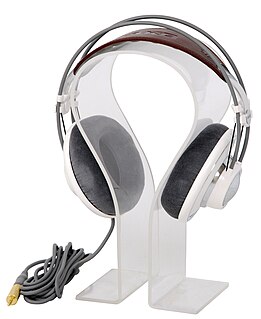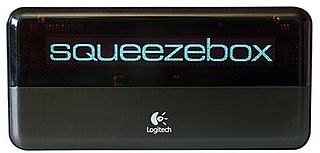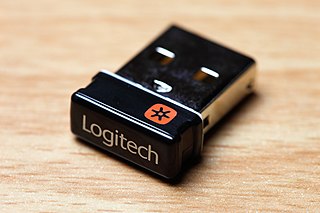Bluetooth is a short-range wireless technology standard that is used for exchanging data between fixed and mobile devices over short distances and building personal area networks (PANs). It employs UHF radio waves in the ISM bands, from 2.402 GHz to 2.48 GHz. It is mainly used as an alternative to wire connections, to exchange files between nearby portable devices and connect cell phones and music players with wireless headphones. In the most widely used mode, transmission power is limited to 2.5 milliwatts, giving it a very short range of up to 10 metres (33 ft).

Headphones are a pair of small loudspeaker drivers worn on or around the head over a user's ears. They are electroacoustic transducers, which convert an electrical signal to a corresponding sound. Headphones let a single user listen to an audio source privately, in contrast to a loudspeaker, which emits sound into the open air for anyone nearby to hear. Headphones are also known as earspeakers, earphones or, colloquially, cans. Circumaural and supra-aural headphones use a band over the top of the head to hold the speakers in place. Another type, known as earbuds or earpieces consist of individual units that plug into the user's ear canal. A third type are bone conduction headphones, which typically wrap around the back of the head and rest in front of the ear canal, leaving the ear canal open. In the context of telecommunication, a headset is a combination of headphone and microphone.

Logitech International S.A. is a Swiss-American multinational manufacturer of computer peripherals and software, with headquarters in Lausanne, Switzerland and Newark, California. The company has offices throughout Europe, Asia, Oceania, and the Americas, and is one of the world's leading manufacturers of input and interface devices for personal computers (PCs) and other digital products. It is a component of the flagship Swiss Market Index.
Denon is a Japanese electronics company started in 1910 by Frederick Whitney Horn, an American entrepreneur. Denon produced the first cylinder audio media in Japan and players to play them. Decades later, Denon was involved in the early stages of development of digital audio technology, while specializing in the manufacture of high-fidelity professional and consumer audio equipment. Denon made Japan's first professional disc recorder and used it to record the Hirohito surrender broadcast. For many decades, Denon was a brand name of Nippon-Columbia, including the Nippon Columbia record label. The Denon brand came from a merger of Denki Onkyo and others in 1939. In 2001, Denon was spun off as a separate company with 98% held by Ripplewood Holdings and 2% by Hitachi. In 2002, Denon merged with Marantz to form D&M Holdings. On March 1, 2017, Sound United LLC completed the acquisition of D+M Holdings.

Squeezebox is a family of network music players. The original device was the SliMP3, introduced in 2001 by Slim Devices. It had an Ethernet interface and played MP3 music files from a media server. The first Squeezebox was released two years later and was followed by several more models. Slim Devices was acquired by Logitech in 2006.
Various accessories for the PlayStation 3 video game console have been produced by Sony and third-party companies. These include controllers, audio and video input devices like microphones, video cameras, and cables for better sound and picture quality.

Open Interface North America (OINA) was a privately owned embedded Bluetooth software provider based in Seattle, Washington and was incorporated in 2000 as a division of the Japanese company Open Interface, Inc., which had formed in 1992. Akemi Sagawa, a Microsoft product manager at the time, was hired to run it. Another former Microsoft employee, Greg Burns, was brought in as chief technology officer.

Headsets connect over a telephone or to a computer, allowing the user to speak and listen while keeping both hands free. They are commonly used in customer service and technical support centers, where employees can converse with customers while typing information into a computer. Also common among computer gamers are headsets, which will let them talk with each other and hear others, as well as use their keyboards and mice to play the game.

Wireless speakers are loudspeakers that receive audio signals using radio frequency (RF) waves rather than over audio cables. The two most popular RF frequencies that support audio transmission to wireless loudspeakers include a variation of WiFi IEEE 802.11, while others depend on Bluetooth to transmit audio data to the receiving speaker.

AirPods are wireless Bluetooth earbuds designed by Apple Inc. They were first announced on September 7, 2016, alongside the iPhone 7. Within two years, they became Apple's most popular accessory. The most recent model, AirPods, are a replacement to the 1st and 2nd Generation models, although the 2nd Generation is still sold on Apple's website. These models are Apple's entry-level wireless headphones, sold alongside the AirPods Pro and AirPods Max.
Bluetooth Low Energy is a wireless personal area network technology designed and marketed by the Bluetooth Special Interest Group aimed at novel applications in the healthcare, fitness, beacons, security, and home entertainment industries. It is independent of classic Bluetooth and has no compatibility, but Bluetooth Basic Rate/Enhanced Data Rate (BR/EDR) and LE can coexist. The original specification was developed by Nokia in 2006 under the name Wibree, which was integrated into Bluetooth 4.0 in December 2009 as Bluetooth Low Energy.

Dolby Headphone is a technology developed by Lake Technology (Australia), that later sold marketing rights to Dolby Laboratories, sometimes referred to as Mobile Surround, which creates a virtual surround sound environment in real-time using any set of two-channel stereo headphones. It takes as input either a 5.1 or a 7.1 channel signal, a Dolby Pro Logic II encoded 2 channel signal or a stereo 2 channel signal. It sends as output a 2 channel stereo signal that includes audio cues intended to place the input channels in a simulated virtual soundstage.
A photovoltaic keyboard is a wireless computer keyboard that charges its batteries from a light source such as the sun or interior lighting, addressing a major drawback of wireless computer peripherals that otherwise require regular replacement of discharged batteries. The first keyboard that was solar-powered was Logitech K750 that was announced by the company in 2010. In 2018 Microsoft filed a patent describing how solar panels could be used to extend battery life for Microsoft's Surface Pro.

The Logitech Unifying receiver is a small dedicated USB wireless receiver, based on the nRF24L-family of RF devices, that allows up to six compatible Logitech human interface devices to be linked to the same computer using 2.4 GHz band radio communication. Receivers that are bundled with a Logitech product are paired with the device at the factory. When purchasing a replacement receiver or connecting multiple devices to one receiver, pairing requires the free-of-charge Logitech Unifying software, available for Microsoft Windows and Mac OS X. On Linux the Solaar software can be used to adjust the configurations. Although not compatible with Bluetooth, devices pair to Unifying Receivers in a similar way. Peripherals remain paired, and can then be used on systems not supporting the software. Logitech receivers compatible with the Unifying protocol can be identified by the orange Unifying logo, which distinguishes them from Logitech Nano receivers of similar appearance, which pair in a similar manner but only with a single device, without using the Unifying protocol.

A wireless keyboard is a computer keyboard that allows the user to communicate with computers, tablets, or laptops with the help of radio frequency (RF), such as WiFi and Bluetooth or with infrared (IR) technology. It is common for wireless keyboards available these days to be accompanied by a wireless mouse.

Jaybird is a Utah-based consumer electronics company owned by Logitech. The company designs and manufactures headphones and wearable activity trackers. The company is mainly known for its line of wireless Bluetooth sports headsets. Jaybird was founded in 2006 by Australian entrepreneur Judd Armstrong.

Bragi is a German technology company headquartered in Munich, Germany, that designs, develops and sells wireless smart earphones; the Bragi OS, the operating system for next-generation computing platforms; and the Bragi App for smartphones.

LDAC is a proprietary audio coding technology developed by Sony, which allows streaming high-resolution audio over Bluetooth connections at up to 990 kbps at 24 bit/96 kHz. It is used by various products, including headphones, earphones, smartphones, portable media players, active speakers, and home theaters.












